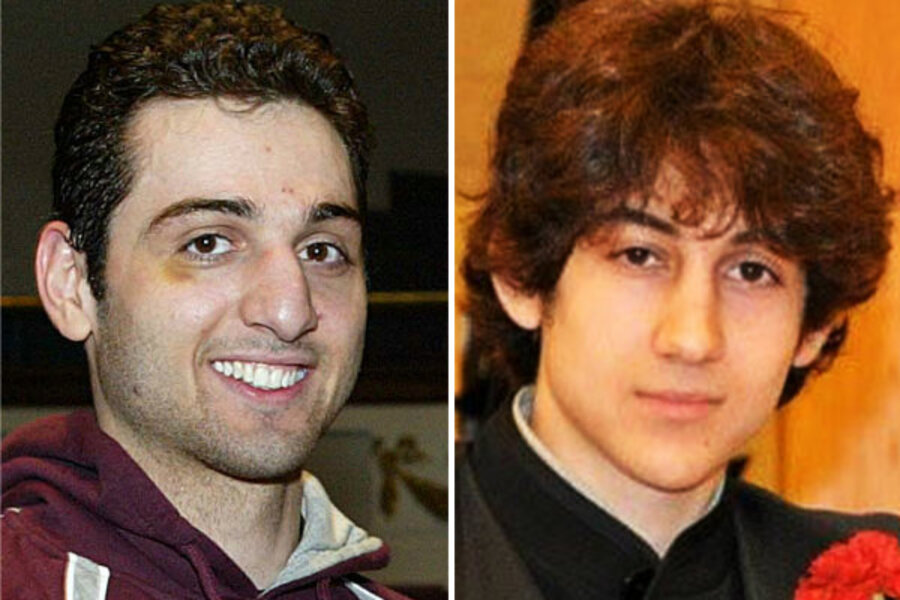Reminder from Boston Marathon bombings: A need to integrate immigrant children
Loading...
| Washington
As soon as Tamerlan and Dzhokhar Tsarnaev, the alleged perpetrators of the Boston Marathon bombings, were identified as Chechen immigrants, and then as refugees, questions were raised about where the system had gone wrong to admit them to the United States. But careful examination of the known facts reveals no flaws in the asylum system; it worked as it should have.
The tragedy in Boston could not have been foreseen in the case files of an 8-year-old asylum seeker and his 15-year-old brother. What can – and has – been questioned is whether authorities at all levels in the US do enough to integrate immigrant children into mainstream American life. (The same question could, of course, be asked about other disadvantaged children in the country’s underclass or those who suffer from undiagnosed or inadequately treated mental illness.)
To immigrants in general, the US offers a bootstraps approach: a generous admissions policy compared to most other developed countries and very little help for those who take up the offer. A condition for legal immigration is that the immigrant is not likely to become a “public charge.”
An exception is made for refugees and asylum seekers, in recognition of the fact that they were compelled to leave their home countries for fear of persecution. But even for them, assistance is very limited – about seven months of cash assistance and help in connecting to a job, housing, and most of the public benefits available to US citizens.
The Tsarnaevs’ family origins in Chechnya gave them a solid claim to a “well-founded fear of being persecuted,” in the language of US and international refugee law. When the Tsarnaev family briefly moved to Chechnya from Kyrgyzstan after the break-up of the Soviet Union in 1991, things may have looked promising for the region.
But life in Chechnya became a nightmare after Russia invaded in 1994 to end Chechnya’s bid for independence. The subsequent turmoil tossed the family back to Kyrgyzstan, then to Dagestan, Mrs. Tsarnaev’s family homeland, and on to the US in 2002. Tamerlan would follow his parents and younger brother Dzhokhar to the US a year later.
Chechens as a group were always subject to discrimination throughout the Soviet Union, and from 1999 on, they were also tainted with the terrorist attacks that Chechen militants visited on Moscow and other Russian cities. Chechens, even those like the Tsarnaevs who had nothing to do with the insurgency, were subject not only to discrimination but attack, including by the police. By 2003, Chechens were by far the largest group of asylum seekers in Europe.
Tens of thousands of Chechens were granted asylum in the European Union, but many were pushed back to the borders of the EU, returned to countries that offered no effective protection, or even sent back to Russia. It was a logical move for a man like Aznor Tsarnaev, looking for a decent prospect for his family, to seek asylum in the US, especially since he had family already settled there. In 2003, the US had the second highest recognition rate for asylum seekers from Russia of any country, second only to Austria (which had given asylum status to 17,000 Chechens by 2005).
The Tsarnaev family showed no signs of anything more sinister than homesickness in most of their time in the US. The brothers’ journey to disaffection, violence (in the case of the elder brother), and finally terrorism has yet to be fully traced. But to say that they should not have been given asylum in 2002 is to deny an honorable tradition of the United States as well as the facts of the Tsarnaevs’ history.
They had every reason to claim – and be granted – asylum. If US authorities had made a blanket decision that children from Russia were potential terrorists, they would have turned away 6-year-old Sergey Brin, the computer genius who co-founded Google, along with 8-year-old Dzhokar Tsarnaev.
The laissez-faire immigration system of the US permits catastrophic failures as well as off-the-charts successes, though the reality for most newcomers to the United States lies well between those two extremes. One way to guard against failures is to pay more attention to the integration of children who come to the US, especially those who may be troubled by the legacies of war-torn areas, and to be alert to signs of disaffection.
A little help getting settled in the first few months after arrival does not constitute sufficient support for refugee families. A longer and deeper engagement both by government agencies and communities is needed to heed warning signs like a fall-off in school performance, a turning away from friends and activities, gang involvement or previously unheard-of aggressiveness.
Such developments should prompt teachers, coaches, friends, and religious figures to ask questions and let kids know that someone notices them and cares what happens. If their families and ethnic communities feel themselves fully part of this country, they will be part of that effort as well.
Kathleen Newland directs the Migration Policy Institute’s refugee protection program. She serves on the boards of the International Rescue Committee, USA for UNHCR, Kids in Need of Defense (KIND), and the Stimson Center. She is a chair emerita of the Women's Commission for Refugee Women and Children.





